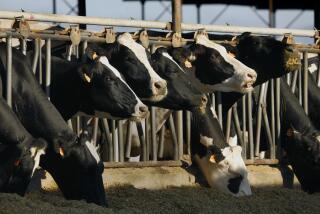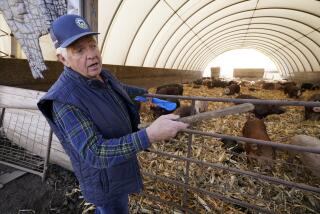It Came From the Pig Lagoon
- Share via
AMES, Iowa — Six plastic bags, swollen with trapped air, bounce around the back seat of the Buick. It’s a good thing they’re not leaking, Dwaine Bundy says as he drives, because the bags are filled with stink.
Bundy has just spent his lunch hour collecting the foul gases that hover over a lagoon brimming with 400,000 gallons of runny hog manure. He’ll deliver the air to his lab at Iowa State University, where a team of trained sniffers will determine just how badly it reeks.
In the spare, bare-walled lab -- equipped with such instruments as the Nasal Ranger -- Bundy evaluates products designed to take the smell out of pig farms.
Today, he’s testing whether a lagoon cover made of shredded tires traps manure odor before it can waft into the air. From orange-scented barn deodorizers to ultrasonic manure sterilizers, Bundy has no shortage of products to study.
As the pork industry has consolidated over the last two decades, with scattered barnyard farms giving way to city-sized compounds of 100,000 hogs, odor has become a critical social issue for rural communities from North Carolina to Utah.
Hogs emit at least 160 odorous compounds -- trace amounts of gases that rise off their skin and their waste. A few, like hydrogen sulfide and ammonia, can damage human health. Others simply smell bad.
“It stinks about enough to make you sick,” said Kurt Kelsey, whose family has farmed near Iowa Falls since 1860.
The smell of swine was not overwhelming when most farms had a few hundred animals. But when thousands are packed into narrow confinement sheds, their meaty, musty, musky smell can saturate homes miles away.
Each pig produces as much waste in a week as three or four people -- eight liquid gallons of manure. It’s too expensive to treat it in waste water plants that handle human sewage. So most pork producers store the manure in giant outdoor lagoons, some big enough to go boating on. They let it sit for up to a year until they can spread it on cropland before the spring planting.
Unless it is injected deep into the soil, manure fertilizer can smell awful. The lagoons are a potent source of stink too; bacteria feed on the waste, breaking it down to nutrients and releasing foul gases as they digest.
Even in a farm state like Iowa, which boasts five pigs for every person, many residents have had enough.
Making a Stink
By the score, they are suing confinement facilities as agricultural nuisances that drag down property values and make life downwind unbearable.
In some regions, suburban transplants expecting a clean, quiet country life have proved the toughest foes of big hog farms. In Iowa, many of the litigants are farmers themselves. They may have worked around livestock for decades but say they are physically sickened by the scale of modern agriculture. Blaming “factory farms” for their headaches, nausea and asthma, more than a dozen plaintiffs in Iowa have won damages ranging from $5,000 to $320,000.
That scares pork producers. “It’s always in the back of your mind,” said Gary Ledger, who raises 3,000 hogs near Williamsburg, a small town in east-central Iowa. “Someone could file a nuisance complaint that would destroy our business.”
In such fear, entrepreneurs sense a gold mine.
They have developed lagoon covers made of clay pellets, straw and felt. They’re tinkering with swine feed -- even adding extracts of yucca and sagebrush -- in hopes of making manure more fragrant.
At costs that range from a dime to several dollars per hog, they peddle devices to zap manure with electricity, blast-dry it at super heat, or bombard it with ultrasonic waves.
A Florida firm recently snagged $650,000 in state and federal grants to build an experimental chamber that will subject manure to temperatures as hot as the sun and atmospheric pressure equal to that on the ocean floor. A spokesman for Global Resource Recovery Organization said the “very violent environment” breaks down the waste so thoroughly that it emerges from the chamber 97% odor free.
Then there are the decidedly low-tech bugs-in-a-bucket products -- microbial mixtures designed to be dumped into manure pits. The microbes speed the breakdown of waste; in the process, they set the manure bubbling and burbling like witch’s brew.
“We’ve got people out here in Kansas who talk about having to store their good clothes [in town] so they don’t smell in church on Sunday. This is a phenomenal problem,” said Stan Irvin, who promises less stink in 10 days with his Biozyme microbe mix, sold by Heartland Enterprises, an agricultural products company based in Hays, Kan.
So hot is the field of swine deodorizing that Premium Standard Farms, the nation’s second-largest pork producer, fields hundreds of pitches a year from inventors hoping to test their products on the company’s enormous farms in Missouri, North Carolina and Texas.
“I get a call about every day,” said Dave Townsend, vice president of environmental affairs.
Farmers Fearful
Bundy, too, spends hours each week on the phone -- with hog farmers panicked that their neighbors may sue. A professor of agricultural engineering, Bundy contracts with pork producers to evaluate the latest technology in odor management.
Picking up the phone the other day, he heard from a farmer who had called before, feeling threatened.
“I hear you got a problem,” Bundy said.
The farmer, who raises 2,500 hogs, explained that a neighbor a mile west griped about unbearable barn odors. “How serious is she?” Bundy asked, frowning. “Now’s a good time to catch her with the idea we’re doing something to control this.”
He recommended a pump that can be programmed to spritz a cherry-scented odor neutralizer into the wind whenever the wind blows toward the angry neighbor. He also suggested planting a row of trees to catch the smelly dust that sloughs off hogs’ skin and floats on the breeze.
“You’ll spend a few thousand dollars,” Bundy said, sighing as the farmer thanked him.
To Bundy, the answer to odor angst is regulation: States should set limits for smell emissions.
Farmers would have less to fear from sensitive neighbors because they wouldn’t be expected to get livestock odors down to zero. And neighbors would be able to call the state for help if the smells got more intense.
Regulating Smells
So far, Colorado is alone in enforcing smell standards for pig farms. The state also requires that manure lagoons be covered. The measures appear to be working. Apart from one family that reports unbearable odor several times a week, Colorado logs just a few complaints a year.
Missouri and Minnesota are working on similar regulations. After a contentious debate, Iowa has shelved its proposed rules for at least two years while 34 state-certified “odor inspectors” conduct a study of farm smells.
In the meantime, residents like Jim Kleemeier, 62, are taking to the courts.
He won $15,000 last year after suing a 4,000-hog confinement farm a quarter mile east of his home near Rockwell City, Iowa. The award was for reduced property value. Kleemeier, a retired truck driver and cattle rancher, thinks he should have been compensated as well for his suffering.
“It stinks to high heaven,” he said. “There’s no more good, clean air. You can’t hardly stand to be outside anymore.”
Hoping to fend off such clashes, one rural Michigan county recently published a brochure to warn prospective residents what to expect if they buy in agricultural areas.
The pamphlet, produced by fast-growing Ottawa County, describes the clatter of farm machinery before dawn. It also includes a scratch ‘n’ sniff manure odor so nauseatingly authentic, the print shop had to evacuate during production.
In a similar spirit, a Canadian pork company looking to expand in North Dakota has taken more than 100 prospective neighbors on smell tours of its facilities in Manitoba.
Craig Jarolimek, an Elite Swine marketing manager, takes the groups to a lagoon filled with 8 million gallons of manure and covered with barley straw. He also leads them into the confinement sheds, where hogs are fed a special diet that reduces the smell from the waste. He encourages his visitors to breathe deeply.
“Their perceptions of what it will smell like are based on management practices from 10 years ago. When they see what proper odor management can accomplish, they’re amazed,” Jarolimek said.
Though public protest over the summer forced Elite Swine to cancel plans for one North Dakota facility, it began building two others in the state this month, with little opposition.
“It’s still animal agriculture, and animals do emit odors,” Jarolimek said. But with the new technology, “it’s manageable,” he said. “It’s livable.”
The key is to figure out which products work.
Enter Dwaine Bundy and his plastic bags.
He has been hired to do off-farm research such as evaluating kitty litter odor. But most of the 2,500 air samples he tests annually come from hogs.
For on-the-spot measurement, Bundy uses the portable Nasal Ranger. Shaped like an oversized hair drier, the device sucks precise quantities of smelly air into a chamber, where it’s blended with charcoal-filtered clean air. He inhales the mixture through cushioned nostril holes. If he cannot smell anything, he increases the ratio of stinky air to clean air, then inhales again.
The goal is to determine how strong the offensive odor is by measuring how much clean air it takes to dilute it until it’s imperceptible. An odor is generally considered noxious if it can be detected even when diluted by seven times as much clean air.
Bundy acknowledges that the technology isn’t all that sophisticated; results require a judgment call. But because the bad-smelling gases are present in such trace amounts -- measurable in parts per trillion -- few instruments are sensitive enough to measure them.
In the end, he said, the human nose is the best odor gauge around.
Still, he hates to rely on a single nose, so Bundy usually brings air samples back to his lab for testing by a panel of eight students in this college town in central Iowa.
One by one, each student leans into the nose mask on the Ac’scent International Olfactometer, a metal box about the size of a washing machine. The $30,000 olfactometer mixes hog-lot air and clean air much as the Nasal Ranger does.
When the student turns a knob, the machine blasts the mixture into the nose mask for three seconds. The student inhales deeply, pushing a green button whenever he detects an odor.
At high concentrations, the smell is so sharp, it burns. But most of the time, the panelists are working with far more subtle odors, barely identifiable as pig. For $8.50 an hour, they’re more than willing to inhale.
“Long as I’m earning money,” said Gaurav Sangtani, an engineering student.
Bundy’s lab has identified several promising technologies. Covering a lagoon with shredded tires can reduce odors by 90%. Some microbial mixes don’t work at all, but others can cut smells by 60%.
Premium Standard has invested $3.6 million in permeable felt covers for 90 of its Missouri lagoons; Bundy says they absorb 40% to 50% of the smell.
Chris Dickel, who raises organic soy half a mile from Premium Standard’s barns in northern Missouri, says the covers work so well, he often forgets there are tens of millions of gallons of manure just on the other side of the hayfield.
Every now and then, though, Dickel catches an overwhelming whiff of “straight pig” from the confinement shed. He figures that’s life in rural America these days.
With 132,000 hogs next door, “you wouldn’t get the smell down to zero,” he said, “even if you had a diaper on every one of them.”
More to Read
Sign up for Essential California
The most important California stories and recommendations in your inbox every morning.
You may occasionally receive promotional content from the Los Angeles Times.













